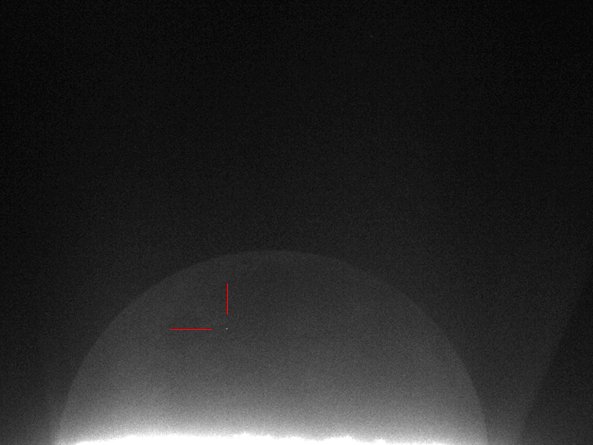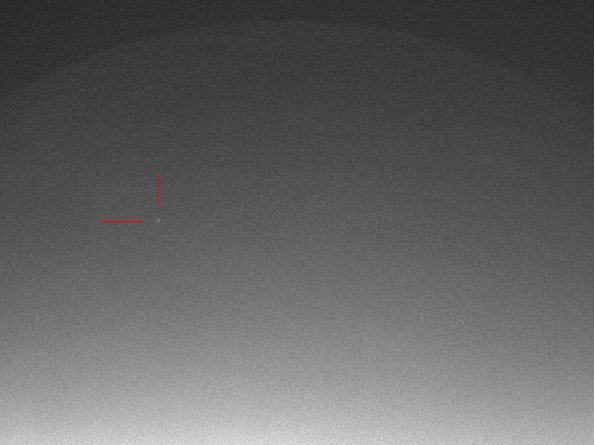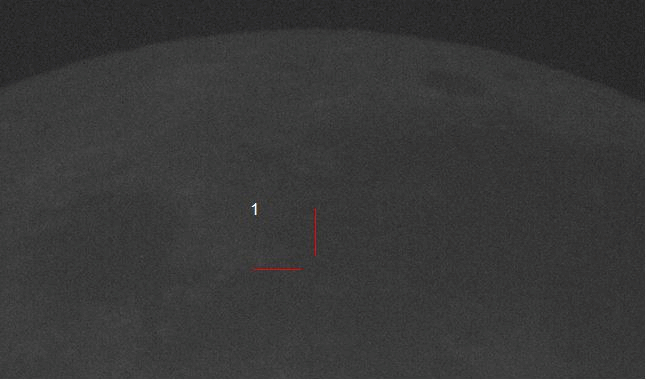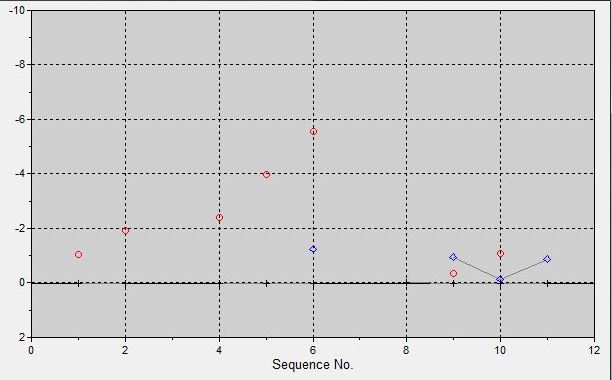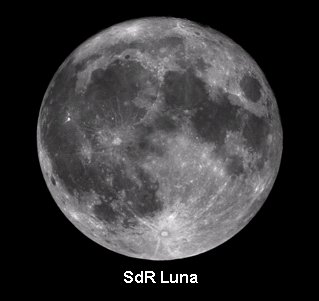Candidates recorded Impacts
| Riga 1: | Riga 1: | ||
| − | === 2° Candidate Lunar Impact record by SdR Luna UAI === | + | === 2° Candidate Lunar Impact record by SdR Luna UAI === |
| − | On | + | On 2016 June 12 at 20h26m59s UT the members of UAI Lunar Section Bruno Cantarella and Luigi Zanatta (Melazzo, AL, Italy, 44°39'25" North, 8°25'52" East) have recorded the second flash of meteoroid impact on the lunar surface. The observation and record has been made with two different telecopes, Newton 100/400 f/4 and Newton 200/1000 f/5 with two astronomical videocamera ZWO mod. ASI 120MM at frame rate of 25 fps and image resoution of 640x480. Entrambi i telescopi al momento delle osservazioni erano installati su una unica montatura equatoriale EQ6 della Skywatcher. Attualmente il Candidato Impatto non è stato confermato da altri osservatori indipendenti. Dopo l'invio dei dati osservativi da parte del Coordinatore del Programma Impatti Lunari al Marshall Space Flight Center della NASA, il Team statunitense come nel caso del primo Candidato Impatto registrato dagli stessi membri della SdR Luna in data 12 Marzo 2016, ha valutato in modo positivo il risultato ottenuto ed ha classificato il nuovo flash come Candidato Impatto lunare n°29 nella lista degli osservatori indipendenti. Il fenomeno è durato 0,08 secondi (1/12 sec.), e la zona dell'impatto è stata individuata alle coordinate selenografiche di 37,0° Ovest e 10,5° Sud +/-0,3° sempre nella parte meridionale dell'Oceanus Procellarum, e più precisamente a Sud-Est del cratere Scheele. Di seguito sono pubblicate le due immagini dove compare il fenomeno da impatto indicato da due linee rosse e ripreso dai due strumenti diversi impiegati per l'osservazione e la registrazione.<br><br> |
<br> | <br> | ||
| Riga 31: | Riga 31: | ||
<br> | <br> | ||
| − | === First Candidate Lunar Impact | + | === First Candidate Lunar Impact recorded by SdR Luna UAI === |
| | ||
| Riga 43: | Riga 43: | ||
<br> | <br> | ||
| − | On 12 March 2016 at 18h 33m 02s UT the members of Section Bruno Cantarella and Luigi Zanatta (Melazzo, AL, Italy, 44°39'25" North, 8°25'52" East) | + | On 12 March 2016 at 18h 33m 02s UT the members of UAI Lunar Section Bruno Cantarella and Luigi Zanatta (Melazzo, AL, Italy, 44°39'25" North, 8°25'52" East) have recorded the first flash of impact of one meteoroid on the Lunar surface. The observation and the record has been made with one unique Newton telescope 200/1000 at f/5 with astronomical videocamera ZWO mod. ASI 120MM with a frame rate of 25 fps and image's resolution of 1024 X 600. Currently the Candidate Impact has been not confirmed by others indepedents observers. After the send of observatives data by the Lunar Impacts Project's Coordinator to NASA's Marshall Space Fligth Center, the American Team has valued in positive mode the obtained result and has classified the flash as Candidate Lunar Impact n° 28 in the list of Independent Observers. Also has been made by Dott. Alessandro Marchini Responsible of Astronomical Observatory of the University of Siena (Italy) a first light curve of impact flash that at the moment of the luminosity peak has been 250 units more bright than lunar surface around at the impact zone. The phenomenon it is lasted 0.08 seconds (1/12 sec.), and the impact zone has been detected at the selenographics coordinates of 39.9° West and 8.0° South +/-0.2°, in the southern zone of Oceanus Procellarum, and more precisely to South-West of the crater Wichmann B. |
<br> | <br> | ||
Versione delle 19:15, 17 lug 2017
2° Candidate Lunar Impact record by SdR Luna UAI
On 2016 June 12 at 20h26m59s UT the members of UAI Lunar Section Bruno Cantarella and Luigi Zanatta (Melazzo, AL, Italy, 44°39'25" North, 8°25'52" East) have recorded the second flash of meteoroid impact on the lunar surface. The observation and record has been made with two different telecopes, Newton 100/400 f/4 and Newton 200/1000 f/5 with two astronomical videocamera ZWO mod. ASI 120MM at frame rate of 25 fps and image resoution of 640x480. Entrambi i telescopi al momento delle osservazioni erano installati su una unica montatura equatoriale EQ6 della Skywatcher. Attualmente il Candidato Impatto non è stato confermato da altri osservatori indipendenti. Dopo l'invio dei dati osservativi da parte del Coordinatore del Programma Impatti Lunari al Marshall Space Flight Center della NASA, il Team statunitense come nel caso del primo Candidato Impatto registrato dagli stessi membri della SdR Luna in data 12 Marzo 2016, ha valutato in modo positivo il risultato ottenuto ed ha classificato il nuovo flash come Candidato Impatto lunare n°29 nella lista degli osservatori indipendenti. Il fenomeno è durato 0,08 secondi (1/12 sec.), e la zona dell'impatto è stata individuata alle coordinate selenografiche di 37,0° Ovest e 10,5° Sud +/-0,3° sempre nella parte meridionale dell'Oceanus Procellarum, e più precisamente a Sud-Est del cratere Scheele. Di seguito sono pubblicate le due immagini dove compare il fenomeno da impatto indicato da due linee rosse e ripreso dai due strumenti diversi impiegati per l'osservazione e la registrazione.
Il flash da Impatto ripreso da Bruno Cantarella (Melazzo, AL), Newton 100/400 ad f/4, videocamera ASI 120MM
Il flash da Impatto ripreso da Luigi Zanatta (Melazzo, AL), Newton 200/1000 ad f/5, videocamera ASI 120MM
First Candidate Lunar Impact recorded by SdR Luna UAI
In the animated image it is visible the sequence of impact flash, with the peak in the frame 2 and in decreasing luminosity in the frame 3
On 12 March 2016 at 18h 33m 02s UT the members of UAI Lunar Section Bruno Cantarella and Luigi Zanatta (Melazzo, AL, Italy, 44°39'25" North, 8°25'52" East) have recorded the first flash of impact of one meteoroid on the Lunar surface. The observation and the record has been made with one unique Newton telescope 200/1000 at f/5 with astronomical videocamera ZWO mod. ASI 120MM with a frame rate of 25 fps and image's resolution of 1024 X 600. Currently the Candidate Impact has been not confirmed by others indepedents observers. After the send of observatives data by the Lunar Impacts Project's Coordinator to NASA's Marshall Space Fligth Center, the American Team has valued in positive mode the obtained result and has classified the flash as Candidate Lunar Impact n° 28 in the list of Independent Observers. Also has been made by Dott. Alessandro Marchini Responsible of Astronomical Observatory of the University of Siena (Italy) a first light curve of impact flash that at the moment of the luminosity peak has been 250 units more bright than lunar surface around at the impact zone. The phenomenon it is lasted 0.08 seconds (1/12 sec.), and the impact zone has been detected at the selenographics coordinates of 39.9° West and 8.0° South +/-0.2°, in the southern zone of Oceanus Procellarum, and more precisely to South-West of the crater Wichmann B.
The sequence of the impact flash obtained with analysis software LunarScan 2.00
The light curve of the flash obtained with MaxIm DL5 software
